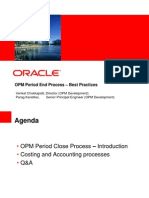sql_interview
Uploaded by
gokul nathsql_interview
Uploaded by
gokul nathAJAY KADIYALA - Data Engineer
Follow me Here:
LinkedIn:
https://www.linkedin.com/in/ajay026/
Data Geeks Community:
https://lnkd.in/gU5NkCqi
SQL
INTERVIEW QUESTIONS
KIT FOR
DATA ENGINEERS
Copy Rights Reserved
SQL is the backbone of data engineering, essential for
efficiently handling and querying large datasets. It's not just for
databases anymore—SQL is key in tools like Apache Spark for
big data processing. It’s a must-have in interviews, where SQL
skills are often the first thing tested. Mastering SQL also helps
you collaborate with analysts and scientists and forms a strong
foundation for learning other data tools. In short, SQL is a core
skill every data engineer needs to succeed.
This document contains 150+ SQL interview questions
focusing on medium to advanced topics. This also Contains
Recently asked questions in my interviews, and Scenario based
questions. I have provided the Solution with Explanation to
help you understand SQL concepts that are crucial for data
engineering roles and to ace your interviews.
Table of Contents:
1. Why SQL
2. Significance of SQL for Interviews.
3. SQL Roadmap
4. Top SQL Commands
5. 5 SQL Projects you can practice.
6. 150+ SQL Interview questions (Scenario based)
7. Best Practices for SQL
8. FREE Resources.
Copy Rights Reserved
Complex Join Optimization
Question: You have three tables: Customers, Orders, and
Payments. Write a query to find all customers who have made
an order but have not completed a payment in the last 30 days.
Solution:
SELECT c.customer_id, c.name
FROM Customers c
JOIN Orders o ON c.customer_id = o.customer_id
LEFT JOIN Payments p ON o.order_id = p.order_id
AND p.payment_date > NOW() - INTERVAL 30 DAY
WHERE p.order_id IS NULL;
Explanation:
This query uses a LEFT JOIN and checks for null values in the
Payments table to find customers with incomplete payments.
Window Functions in Analytical Queries
Question: For each product sold, calculate the running total of
the number of sales made over time, ordered by sale date.
Solution:
SELECT product_id, sale_date, sales,
SUM(sales) OVER (PARTITION BY product_id ORDER BY
sale_date) AS running_total
FROM Sales;
Explanation:
The window function SUM() calculates a running total within
each product partition.
Copy Rights Reserved
Time-Based Performance Data Analysis
Question: You are given a table Service_Requests with columns
request_id, created_at, and resolved_at. Write a query to
calculate the average time taken to resolve a request (in
hours), excluding weekends.
Solution:
WITH request_durations AS (
SELECT request_id,
EXTRACT(EPOCH FROM (resolved_at - created_at))/3600
AS hours_taken
FROM Service_Requests
WHERE EXTRACT(DOW FROM created_at) BETWEEN 1 AND
5
)
SELECT AVG(hours_taken) AS avg_resolution_time
FROM request_durations;
Explanation:
This query filters out weekends and calculates the average
time to resolve a request in hours.
Identifying Frequent Buyers
Question: Given a Purchases table, find customers who have
made more than 5 purchases in the last 6 months, along with
their total spend.
Solution:
SELECT customer_id, COUNT(*) AS purchase_count,
SUM(amount) AS total_spent
Copy Rights Reserved
FROM Purchases
WHERE purchase_date > NOW() - INTERVAL 6 MONTH
GROUP BY customer_id
HAVING COUNT(*) > 5;
Explanation:
This query identifies frequent buyers and uses HAVING to filter
customers based on their purchase count.
Finding Missing Values
Question: You have a table of student grades. Write a query to
find students who do not have grades for all subjects.
Solution:
SELECT student_id
FROM Student_Grades
GROUP BY student_id
HAVING COUNT(DISTINCT subject_id) < (SELECT COUNT(*)
FROM Subjects);
Explanation:
This query checks for students whose count of distinct subjects
is less than the total subject count.
Top N Employees by Sales
Question: Write a query to find the top 3 employees with the
highest sales in the last year.
Solution:
SELECT employee_id, SUM(sales_amount) AS total_sales
FROM Sales
Copy Rights Reserved
WHERE sale_date >= DATEADD(YEAR, -1, GETDATE())
GROUP BY employee_id
ORDER BY total_sales DESC
LIMIT 3;
Explanation:
This query sums sales for each employee and uses LIMIT to
return the top three.
Calculating Percentiles
Question: How would you write a query to find the 90th
percentile of sales from a Sales table?
Solution:
SELECT PERCENTILE_CONT(0.90) WITHIN GROUP (ORDER BY
sales_amount) AS p90_sales
FROM Sales;
Explanation:
This uses the PERCENTILE_CONT function to calculate the 90th
percentile of the sales.
Handling Nulls in Aggregations
Question: How can you write a query that sums the total sales
but treats null values as zero?
Solution:
SELECT SUM(COALESCE(sales_amount, 0)) AS total_sales
FROM Sales;
Explanation:
Copy Rights Reserved
The COALESCE function replaces null values with zero in the
sum.
Date Differences in SQL
Question: Write a query to find the average time taken
between order creation and delivery.
Solution:
SELECT AVG(DATEDIFF(day, order_date, delivery_date)) AS
avg_delivery_time
FROM Orders;
Explanation:
DATEDIFF calculates the difference in days, and AVG returns
the average time.
Dynamic SQL for Reporting
Question: Write a dynamic SQL query to generate a report of
sales per month for a given year.
Solution:
DECLARE @Year INT = 2023;
EXEC('SELECT MONTH(sale_date) AS Month,
SUM(sales_amount) AS TotalSales
FROM Sales
WHERE YEAR(sale_date) = ' + CAST(@Year AS VARCHAR) + '
GROUP BY MONTH(sale_date);');
Explanation:
Dynamic SQL is constructed and executed to report monthly
sales for the specified year.
Copy Rights Reserved
Query Performance Optimization Techniques
Question: How can you identify and optimize slow-running
queries in SQL?
Solution:
-- Use the EXPLAIN command to analyze query execution plans.
EXPLAIN SELECT * FROM Orders WHERE customer_id = 123;
-- Add appropriate indexes to improve query speed
CREATE INDEX idx_customer_id ON Orders (customer_id);
-- Optimize joins and reduce the number of rows processed.
SELECT o.order_id, c.customer_name
FROM Orders o
JOIN Customers c ON o.customer_id = c.customer_id
WHERE c.region = 'North';
Explanation:
You can optimize slow-running queries by analyzing execution
plans, adding indexes, and optimizing joins.
Temporary vs. Permanent Tables
Question: What are the differences between temporary and
permanent tables, and when would you use each?
Solution:
-- Temporary Table (Exists for the session)
CREATE TEMPORARY TABLE temp_orders AS
SELECT * FROM Orders;
Copy Rights Reserved
-- Permanent Table (Exists indefinitely until dropped)
CREATE TABLE permanent_orders AS
SELECT * FROM Orders;
Explanation:
Temporary tables are used for session-specific data, while
permanent tables are used for long-term data storage.
Full-Text Search Capabilities
Question: How do you implement full-text search on a column
in SQL?
Solution:
-- Create a full-text index on a column
CREATE FULLTEXT INDEX ON Products(product_description);
-- Use the CONTAINS function to search for a keyword
SELECT * FROM Products WHERE
CONTAINS(product_description, 'laptop');
Explanation:
Full-text indexes and the CONTAINS function allow for
advanced text searching in SQL databases.
Working with Hierarchical Data
Question: How do you query hierarchical data stored in a self-
referencing table?
Solution:
WITH Hierarchy AS (
SELECT employee_id, manager_id, name, 0 AS Level
Copy Rights Reserved
FROM Employees
WHERE manager_id IS NULL
UNION ALL
SELECT e.employee_id, e.manager_id, e.name, h.Level + 1
FROM Employees e
INNER JOIN Hierarchy h ON e.manager_id = h.employee_id
)
SELECT * FROM Hierarchy;
Explanation:
This recursive CTE allows you to retrieve hierarchical data,
starting from top-level managers and finding all related
employees.
Understanding and Implementing Partitioning
Question: Explain how partitioning works in SQL and provide
an example of partitioning a table by date.
Solution:
CREATE TABLE Sales (
sale_id INT,
sale_date DATE,
amount DECIMAL(10, 2)
) PARTITION BY RANGE (YEAR(sale_date)) (
PARTITION p2022 VALUES LESS THAN (2023),
PARTITION p2023 VALUES LESS THAN (2024)
);
Explanation:
Copy Rights Reserved
Partitioning helps manage large datasets by dividing them into
smaller, more manageable pieces, such as by date ranges.
Handling Concurrency in Transactions
Question: How would you manage concurrency issues in SQL,
such as the lost update problem?
Solution:
-- Set transaction isolation level to SERIALIZABLE
SET TRANSACTION ISOLATION LEVEL SERIALIZABLE;
BEGIN TRANSACTION;
-- Perform the update or insert operation
COMMIT;
Explanation:
Setting the transaction isolation level to SERIALIZABLE
ensures that transactions are executed in a way that prevents
concurrency issues.
Calculating Percentiles in SQL
Question: Write a query to calculate the 90th percentile of
sales amounts.
Solution:
SELECT PERCENTILE_CONT(0.90) WITHIN GROUP (ORDER BY
sales_amount) AS p90_sales
FROM Sales;
Explanation:
Copy Rights Reserved
This query uses the PERCENTILE_CONT function to calculate
the 90th percentile of the sales amounts.
Dynamic SQL Execution
Question: Write a dynamic SQL query that generates a report
of sales by region for a given year.
Solution:
DECLARE @Year INT = 2023;
DECLARE @SQL NVARCHAR(MAX);
SET @SQL = 'SELECT region, SUM(sales_amount) AS total_sales
FROM Sales WHERE YEAR(sale_date) = ' + CAST(@Year
AS NVARCHAR) + '
GROUP BY region;';
EXEC sp_executesql @SQL;
Explanation:
Dynamic SQL allows for constructing and executing SQL
statements based on variables, such as the year in this
example.
Window Functions for Running Totals
Question: Write a query to calculate a running total of sales for
each product.
Solution:
SELECT product_id, sale_date, sales_amount,
SUM(sales_amount) OVER (PARTITION BY product_id
Copy Rights Reserved
ORDER BY sale_date) AS running_total
FROM Sales;
Explanation:
This query uses the SUM() window function to calculate a
running total for each product, partitioned by product_id.
Handling NULL Values in SQL
Question: How can you handle NULL values in a SUM operation
to ensure they are treated as zero?
Solution:
SELECT SUM(COALESCE(sales_amount, 0)) AS total_sales
FROM Sales;
Explanation:
The COALESCE function is used to replace NULL values with 0
in the SUM operation to avoid incorrect totals.
Identifying Duplicates in SQL
Question: Write a query to identify duplicate rows in a table
based on a combination of columns.
Solution:
SELECT customer_id, order_id, COUNT(*)
FROM Orders
GROUP BY customer_id, order_id
HAVING COUNT(*) > 1;
Explanation:
Copy Rights Reserved
This query uses GROUP BY and HAVING to find duplicate
records where customer_id and order_id are repeated.
Recursive CTE for Hierarchies
Question: How do you write a recursive CTE to navigate a
hierarchy of departments?
Solution:
WITH DepartmentHierarchy AS (
SELECT department_id, parent_department_id,
department_name, 0 AS Level
FROM Departments
WHERE parent_department_id IS NULL
UNION ALL
SELECT d.department_id, d.parent_department_id,
d.department_name, dh.Level + 1
FROM Departments d
INNER JOIN DepartmentHierarchy dh ON
d.parent_department_id = dh.department_id
)
SELECT * FROM DepartmentHierarchy;
Explanation:
This recursive CTE allows you to retrieve and navigate a
hierarchy of departments by finding all related sub-
departments.
Copy Rights Reserved
Recursive Common Table Expressions
Question: Write a recursive CTE to find all employees in an
organization and their respective managers, given an
Employees table.
Solution:
WITH EmployeeCTE AS (
SELECT employee_id, manager_id, name
FROM Employees
WHERE manager_id IS NULL
UNION ALL
SELECT e.employee_id, e.manager_id, e.name
FROM Employees e
INNER JOIN EmployeeCTE cte ON e.manager_id =
cte.employee_id
)
SELECT * FROM EmployeeCTE;
Explanation:
This recursive CTE starts with top-level managers and
recursively joins to find all employees under each manager.
Data Transformation with CASE
Question: Write a query that categorizes sales amounts into
different ranges using the CASE statement.
Solution:
SELECT sale_amount,
CASE
WHEN sale_amount < 100 THEN 'Low'
Copy Rights Reserved
WHEN sale_amount BETWEEN 100 AND 500 THEN
'Medium'
ELSE 'High'
END AS sale_category
FROM Sales;
Explanation:
This query uses the CASE statement to categorize sales
amounts into 'Low', 'Medium', and 'High'.
Using JSON Functions in SQL
Question: Given a JSON column named `data` in a table, write a
query to extract a specific value from the JSON object.
Solution:
SELECT data->>'$.name' AS customer_name
FROM Customers;
Explanation:
This query extracts the `name` field from a JSON column in the
Customers table.
Ranking Functions and Their Applications
Question: Write a query to rank employees based on their sales
performance within each department.
Solution:
SELECT employee_id, department_id, sales,
RANK() OVER (PARTITION BY department_id ORDER BY
sales DESC) AS sales_rank
FROM EmployeeSales;
Copy Rights Reserved
Explanation:
The RANK() function assigns a rank to each employee based on
their sales, partitioned by department.
Creating Pivot Tables Using SQL
Question: Write a query to pivot sales data to show the total
sales for each product by month.
Solution:
SELECT product_id,
SUM(CASE WHEN MONTH(sale_date) = 1 THEN
sales_amount ELSE 0 END) AS January,
SUM(CASE WHEN MONTH(sale_date) = 2 THEN
sales_amount ELSE 0 END) AS February,
SUM(CASE WHEN MONTH(sale_date) = 3 THEN
sales_amount ELSE 0 END) AS March
FROM Sales
GROUP BY product_id;
Explanation:
This query pivots sales data, aggregating total sales for each
product by month using conditional aggregation.
Advanced Use of GROUP BY with ROLLUP and CUBE
Question: Write a query to calculate total sales with subtotals
for each product and grand total.
Solution:
SELECT product_id, SUM(sales_amount) AS total_sales
FROM Sales
GROUP BY ROLLUP(product_id);
Copy Rights Reserved
Explanation:
The ROLLUP operator provides subtotal and grand total rows
in the result set.
Error Handling in SQL Transactions
Question: How would you write a SQL transaction that rolls
back if an error occurs?
Solution:
BEGIN TRY
BEGIN TRANSACTION;
-- SQL operations
INSERT INTO Orders (order_id, customer_id) VALUES (1, 1);
-- Simulate error
INSERT INTO Orders (order_id, customer_id) VALUES (NULL,
NULL);
COMMIT TRANSACTION;
END TRY
BEGIN CATCH
ROLLBACK TRANSACTION;
PRINT ERROR_MESSAGE();
END CATCH;
Explanation:
This transaction block uses TRY...CATCH for error handling. If
an error occurs, it rolls back all operations.
Implementing Triggers and Their Use Cases
Question: Write a trigger that automatically updates a
timestamp column when a record is modified.
Copy Rights Reserved
Solution:
CREATE TRIGGER UpdateTimestamp
ON Employees
AFTER UPDATE
AS
BEGIN
UPDATE Employees
SET last_modified = GETDATE()
WHERE employee_id IN (SELECT employee_id FROM
inserted);
END;
Explanation:
This trigger updates the `last_modified` column with the
current date and time whenever an employee record is
updated.
Cross Joins and Their Implications
Question: What is a cross join, and provide a query example
that demonstrates its use?
Solution:
SELECT a.name, b.product_name
FROM Customers a
CROSS JOIN Products b;
Explanation:
A cross join produces a Cartesian product, combining every
row from one table with every row from another.
Copy Rights Reserved
Using MERGE Statements for Upserts
Question: Write a query to use the MERGE statement for
updating existing records or inserting new ones.
Solution:
MERGE INTO TargetTable AS target
USING SourceTable AS source
ON target.id = source.id
WHEN MATCHED THEN
UPDATE SET target.value = source.value
WHEN NOT MATCHED THEN
INSERT (id, value) VALUES (source.id, source.value);
Explanation:
The MERGE statement combines insert and update operations
based on matching criteria.
Handling NULL Values in Conditional Aggregations
Question: Write a query that counts the number of orders
placed by customers, treating NULL customer IDs as
'Unknown'.
Solution:
SELECT COALESCE(customer_id, 'Unknown') AS
customer_identifier,
COUNT(order_id) AS total_orders
FROM Orders
GROUP BY COALESCE(customer_id, 'Unknown');
Explanation:
Copy Rights Reserved
This query uses the COALESCE function to treat NULL
customer IDs as 'Unknown' and counts the orders per
customer.
Combining Data from Multiple Sources
Question: How can you combine data from two different tables
that have similar structures, such as Orders2022 and
Orders2023?
Solution:
SELECT * FROM Orders2022
UNION ALL
SELECT * FROM Orders2023;
Explanation:
This query combines rows from two tables using UNION ALL,
which includes all rows without eliminating duplicates.
Updating Data with Conditions
Question: Write a query to update the status of all orders that
have been shipped but not delivered.
Solution:
UPDATE Orders
SET status = 'In Transit'
WHERE shipped_date IS NOT NULL
AND delivered_date IS NULL;
Explanation:
This query updates the order status to 'In Transit' for orders
that have been shipped but not yet delivered.
Copy Rights Reserved
Ranking with DENSE_RANK
Question: Write a query to rank employees by their total sales,
without skipping rank numbers for ties.
Solution:
SELECT employee_id, total_sales,
DENSE_RANK() OVER (ORDER BY total_sales DESC) AS
sales_rank
FROM EmployeeSales;
Explanation:
DENSE_RANK ranks employees by total sales without gaps in
rank numbers for tied values.
Using EXISTS for Subqueries
Question: Write a query to find customers who have placed at
least one order in the last month.
Solution:
SELECT customer_id, customer_name
FROM Customers c
WHERE EXISTS (
SELECT 1 FROM Orders o
WHERE o.customer_id = c.customer_id
AND o.order_date > DATEADD(MONTH, -1, GETDATE())
);
Explanation:
The EXISTS clause checks if a customer has placed at least one
order in the last month, returning only those customers.
Copy Rights Reserved
Recursive Queries for Tree Structures
Question: How would you write a recursive query to retrieve
all managers and their subordinates from an Employees table?
Solution:
WITH EmployeeHierarchy AS (
SELECT employee_id, manager_id, name, 0 AS Level
FROM Employees
WHERE manager_id IS NULL
UNION ALL
SELECT e.employee_id, e.manager_id, e.name, eh.Level + 1
FROM Employees e
INNER JOIN EmployeeHierarchy eh ON e.manager_id =
eh.employee_id
)
SELECT * FROM EmployeeHierarchy;
Explanation:
This recursive query retrieves all employees and their
respective managers, creating a hierarchical tree structure.
Efficient Data Filtering with Indexes
Question: How can you improve the performance of a query
that filters data by customer_id in a large Orders table?
Solution:
CREATE INDEX idx_customer_id ON Orders(customer_id);
-- Query utilizing the index for faster lookups
SELECT * FROM Orders WHERE customer_id = 123;
Copy Rights Reserved
Explanation:
Creating an index on the customer_id column improves the
performance of queries filtering by that column.
Using LAG and LEAD Window Functions
Question: Write a query to compare each employee's sales with
their previous month's sales.
Solution:
SELECT employee_id, sale_month, sales_amount,
LAG(sales_amount) OVER (PARTITION BY employee_id
ORDER BY sale_month) AS previous_month_sales
FROM EmployeeSales;
Explanation:
The LAG function allows you to access the previous month's
sales for each employee in the result set.
Handling Aggregations with DISTINCT
Question: Write a query to count the number of unique
customers who placed orders in the last year.
Solution:
SELECT COUNT(DISTINCT customer_id) AS unique_customers
FROM Orders
WHERE order_date > DATEADD(YEAR, -1, GETDATE());
Explanation:
The DISTINCT keyword ensures that only unique customer_ids
are counted in the result.
Copy Rights Reserved
Creating Custom Aggregates with CASE
Question: Write a query to calculate the total sales for each
product category, with a separate total for 'Electronics'.
Solution:
SELECT category,
SUM(CASE WHEN category = 'Electronics' THEN
sales_amount ELSE 0 END) AS electronics_sales,
SUM(sales_amount) AS total_sales
FROM Sales
GROUP BY category;
Explanation:
This query uses the CASE statement to calculate sales
specifically for 'Electronics' and overall sales for each category.
Combining Multiple Aggregations in a Single Query
Question: Write a query to calculate the average, minimum,
and maximum sales amount for each region.
Solution:
SELECT region,
AVG(sales_amount) AS average_sales,
MIN(sales_amount) AS min_sales,
MAX(sales_amount) AS max_sales
FROM Sales
GROUP BY region;
Explanation:
This query combines multiple aggregation functions (AVG,
MIN, MAX) to provide various statistics for each region.
Copy Rights Reserved
Efficient Pagination with OFFSET and FETCH
Question: Write a query to return the second page of results
from an Orders table, assuming each page shows 10 results.
Solution:
SELECT * FROM Orders
ORDER BY order_date
OFFSET 10 ROWS
FETCH NEXT 10 ROWS ONLY;
Explanation:
This query uses OFFSET and FETCH to skip the first 10 rows
and return the next 10 rows, simulating pagination.
Working with Self-Joins
Question: Write a query to find all employees who share the
same manager in an Employees table.
Solution:
SELECT e1.employee_id, e1.name AS employee_name, e2.name
AS manager_name
FROM Employees e1
JOIN Employees e2 ON e1.manager_id = e2.employee_id;
Explanation:
A self-join is used to match employees with their managers by
joining the Employees table to itself.
Date and Time Calculations
Question: Write a query to calculate the number of days
between an order date and a delivery date.
Copy Rights Reserved
Solution:
SELECT order_id, DATEDIFF(day, order_date, delivery_date) AS
days_to_deliver
FROM Orders
WHERE delivery_date IS NOT NULL;
Explanation:
The DATEDIFF function calculates the difference in days
between the order_date and delivery_date for each order.
Detecting Gaps in Sequences
Question: How can you write a query to detect missing invoice
numbers in a sequence of invoices?
Solution:
WITH OrderedInvoices AS (
SELECT invoice_id, LAG(invoice_id) OVER (ORDER BY
invoice_id) AS prev_invoice
FROM Invoices
)
SELECT invoice_id
FROM OrderedInvoices
WHERE invoice_id <> prev_invoice + 1;
Explanation:
This query uses the LAG window function to compare each
invoice_id with the previous one, detecting gaps in the
sequence.
Copy Rights Reserved
Explain the difference between INNER JOIN, LEFT
JOIN, RIGHT JOIN, and FULL JOIN with examples.
Answer:
• INNER JOIN returns records that have matching values in
both tables.
• LEFT JOIN returns all records from the left table and
matching records from the right.
• RIGHT JOIN returns all records from the right table and
matching records from the left.
• FULL JOIN returns all records when there is a match in
either table.
Example:
SELECT a.column, b.column
FROM table_a a
INNER JOIN table_b b ON a.id = b.id;
How would you find duplicate rows in a table?
Answer: Use GROUP BY and HAVING to count duplicates.
Solution:
SELECT column1, COUNT(*)
FROM table
GROUP BY column1
Copy Rights Reserved
HAVING COUNT(*) > 1;
What’s the difference between RANK() and DENSE_RANK()
in SQL?
Answer:
• RANK() gives gaps in ranking after ties.
• DENSE_RANK() assigns consecutive ranks without gaps.
Example:
Solution:
SELECT column, RANK() OVER (ORDER BY column DESC) AS
rank
FROM table;
How would you remove duplicate rows in SQL?
Answer: Use ROW_NUMBER() with a Common Table
Expression (CTE) to delete duplicates.
Solution:
WITH cte AS (
SELECT column, ROW_NUMBER() OVER(PARTITION BY
column ORDER BY column) AS row_num
FROM table
)
Copy Rights Reserved
DELETE FROM cte WHERE row_num > 1;
Explain window functions and how you would use them in
SQL.
Answer: Window functions perform calculations across a set
of rows related to the current row, like RANK(), SUM(), AVG(),
and ROW_NUMBER(). They are useful for calculations without
collapsing rows.
Solution:
SELECT column, SUM(value) OVER(PARTITION BY category)
AS sum_value
FROM table;
How would you fetch only even-numbered rows from a
table?
Answer:
Solution:
SELECT *
FROM (
SELECT *, ROW_NUMBER() OVER (ORDER BY column) AS
row_num
FROM table
) AS subquery
WHERE row_num % 2 = 0;
Copy Rights Reserved
What is the purpose of the EXPLAIN statement in SQL?
Answer: EXPLAIN analyzes the query execution plan, showing
how tables are accessed, indices used, and estimated costs,
allowing you to optimize queries.
Explain a scenario where you’d use a SELF JOIN.
Answer: Use a SELF JOIN when you need to compare rows
within the same table, such as finding employee-manager
relationships within an employee table.
Solution:
SELECT a.employee_id, b.employee_id AS manager_id
FROM employees a
JOIN employees b ON a.manager_id = b.employee_id;
How can you optimize a query with multiple joins?
Answer: Index columns involved in joins, filter data early, and
order joins so smaller tables are joined first. Use EXPLAIN to
check performance.
Describe the difference between WHERE and HAVING.
Answer: WHERE filters rows before aggregation, while
HAVING filters after aggregation. Use WHERE for raw data and
HAVING for aggregate functions.
Copy Rights Reserved
How would you calculate the cumulative sum in SQL?
Answer:
Solution:
SELECT column, SUM(value) OVER (ORDER BY column ROWS
BETWEEN UNBOUNDED PRECEDING AND CURRENT ROW) AS
cumulative_sum
FROM table;
What is the difference between UNION and UNION ALL?
Answer: UNION removes duplicates, while UNION ALL keeps
all results, including duplicates. UNION ALL is faster for larger
datasets.
How would you delete rows that are duplicates but keep
the first occurrence?
Answer: Use ROW_NUMBER() with a CTE to assign row
numbers and delete duplicates.
Solution:
WITH cte AS (
SELECT *, ROW_NUMBER() OVER(PARTITION BY column
ORDER BY column) AS row_num
FROM table
Copy Rights Reserved
)
DELETE FROM cte WHERE row_num > 1;
Explain a correlated subquery and give an example.
Answer: A correlated subquery is a subquery that depends on
the outer query for its values. Example:
Solution:
SELECT name
FROM employees e1
WHERE salary > (
SELECT AVG(salary)
FROM employees e2
WHERE e1.department_id = e2.department_id
);
What is an index, and how does it improve query
performance?
Answer: An index is a data structure that speeds up data
retrieval by reducing the amount of data scanned. It acts as a
pointer to data rows based on indexed columns.
What’s the difference between a PRIMARY KEY and a
UNIQUE constraint?
Copy Rights Reserved
Answer: Both enforce uniqueness, but PRIMARY KEY also
doesn’t allow NULL values and uniquely identifies each row,
while UNIQUE allows one NULL.
How do you find the nth highest salary in SQL?
Answer:
Solution:
SELECT DISTINCT salary
FROM employees
ORDER BY salary DESC
LIMIT 1 OFFSET n-1;
What is a TRIGGER and when would you use it?
Answer: A TRIGGER automatically executes predefined actions
in response to database events (like insert, update, delete). It’s
useful for logging changes or enforcing rules.
How would you update records in one table based on
values in another table?
Answer: Use JOIN in the UPDATE statement.
Solution:
UPDATE table1
Copy Rights Reserved
SET column = table2.value
FROM table2
WHERE table1.id = table2.id;
Explain the COALESCE function and give an example.
Answer: COALESCE returns the first non-null value among its
arguments, useful for handling missing values.
Solution:
SELECT COALESCE(column1, column2, 0) AS result FROM
table;
How would you remove rows with NULL values in a
specific column?
Answer:
Solution:
DELETE FROM table WHERE column IS NULL;
How would you list all unique pairs of columns from the
same table?
Answer:
Solution:
SELECT DISTINCT a.column1, b.column1
FROM table a
Copy Rights Reserved
JOIN table b ON a.column1 < b.column1;
Explain the GROUP BY clause and when you would use it.
Answer: GROUP BY groups rows sharing a common field, used
with aggregate functions like SUM, COUNT, AVG.
24. What is ACID in database transactions?
Answer: ACID stands for Atomicity, Consistency, Isolation,
Durability. It ensures reliable transactions, essential for
maintaining data integrity.
25. How would you calculate the moving average in SQL?
Answer:
Solution:
SELECT column, AVG(value) OVER(ORDER BY date ROWS
BETWEEN 2 PRECEDING AND CURRENT ROW) AS moving_avg
FROM table;
Explain what a cross join is and when you might use it.
Answer: A cross join returns the Cartesian product of two
tables. It’s rarely used unless you need all possible
combinations of two sets.
Copy Rights Reserved
What is the difference between DELETE and TRUNCATE?
Answer: DELETE removes rows one by one, can have a
WHERE clause, and can be rolled back. TRUNCATE removes all
rows quickly, can’t be rolled back, and resets identity columns.
How do you handle NULL values when joining tables?
Answer: Use LEFT JOIN to retain rows with NULL in one table,
or use IS NULL or COALESCE to manage NULL values.
How would you select records in one table that don’t exist
in another table?
Answer: Use LEFT JOIN or NOT EXISTS.
Solution:
SELECT a.*
FROM table_a a
LEFT JOIN table_b b ON a.id = b.id
WHERE b.id IS NULL;
How would you pivot data in SQL?
Answer: Use conditional aggregation with CASE or use the
PIVOT function if supported.
Copy Rights Reserved
Solution:
SELECT category, SUM(CASE WHEN month = 'January' THEN
value END) AS January
FROM sales
GROUP BY category;
How would you normalize a table, and why is it important?
Answer: Normalization removes redundancy by structuring
data across tables, enforcing dependencies, and improving
consistency.
How would you denormalize data for performance?
Answer: Combine tables to reduce joins, allowing faster reads,
often used in reporting databases.
How would you create an index, and when should you
avoid it?
Answer: Use CREATE INDEX for frequently searched columns
but avoid over-indexing on tables with frequent writes, as it
slows down insertions.
Explain the use of IFNULL and NULLIF.
Answer: IFNULL replaces NULL with a default value, while
NULLIF returns NULL if two expressions are equal.
Copy Rights Reserved
How do you find the first and last records in a grouped
dataset?
Answer:
Solution:
SELECT category, FIRST_VALUE(value) OVER (PARTITION BY
category ORDER BY date) AS first_value
How would you write a recursive query?
Answer: Use Common Table Expressions (CTEs) for recursion.
Solution:
WITH RECURSIVE cte AS (
SELECT column FROM table
UNION ALL
SELECT column FROM table WHERE condition
)
Explain a CASE statement and give an example.
Answer:
Solution:
SELECT name,
Copy Rights Reserved
CASE
WHEN score > 90 THEN 'A'
WHEN score > 80 THEN 'B'
ELSE 'C'
END AS grade
FROM students;
What are SQL constraints, and why are they important?
Answer: Constraints enforce rules on data, such as PRIMARY
KEY, FOREIGN KEY, and CHECK, to maintain integrity.
What is a materialized view?
Answer: A materialized view stores the results of a query
physically for fast access, unlike regular views which are
computed on demand.
How would you schedule an SQL job to run periodically?
Answer: Use database schedulers, such as SQL Server Agent or
cron jobs.
What is the purpose of the LIMIT and OFFSET clauses?
Answer: LIMIT restricts result rows, while OFFSET skips a
number of rows, useful for pagination.
Copy Rights Reserved
Explain the difference between VARCHAR and CHAR.
Answer: CHAR has a fixed length, while VARCHAR is variable-
length, saving space for shorter values.
How would you handle transactional deadlocks in SQL?
Answer: Use retry logic, lower isolation levels, and index
tables appropriately to reduce deadlocks.
What is a stored procedure, and why use one?
Answer: A stored procedure is a saved SQL script that can be
reused, which helps with performance, code organization, and
security.
How would you handle time zone conversions in SQL?
Answer: Use AT TIME ZONE or equivalent functions to convert
between time zones.
Explain the use of PARTITION BY and ORDER BY in
window functions.
Answer: PARTITION BY groups rows, and ORDER BY sets the
order within each partition, crucial for calculations like ranking
and cumulative sums.
Copy Rights Reserved
How do you measure query performance in SQL?
Answer: Use execution plans, query runtime, index usage stats,
and track CPU/memory usage.
What is a temp table, and when would you use it?
Answer: Temporary tables store intermediate results, ideal for
complex queries and session-specific data.
How would you handle schema changes in a production
database?
Answer: Test changes in a staging environment, backup data,
use ALTER TABLE carefully, and communicate downtime if
needed.
What is a CTE, and how does it differ from a subquery?
Answer: A CTE is a temporary result set within a query for
better readability and reusability, while a subquery is a nested
query directly within another query.
How would you identify customers who made a purchase
last year but not this year?
Copy Rights Reserved
Answer: Use a LEFT JOIN and filter out the records with no
matches from this year.
Solution:
SELECT last_year.customer_id
FROM purchases last_year
LEFT JOIN purchases this_year
ON last_year.customer_id = this_year.customer_id AND
this_year.year = 2023
WHERE last_year.year = 2022 AND this_year.customer_id IS
NULL;
Given a sales table, how do you find the top 3 sales
representatives based on total sales?
Answer: Use ORDER BY and LIMIT to rank the sales totals.
Solution:
SELECT representative, SUM(sales) AS total_sales
FROM sales
GROUP BY representative
ORDER BY total_sales DESC
LIMIT 3;
Copy Rights Reserved
How would you find customers who’ve bought all products
in a given product list?
Answer: Use a HAVING clause to count the distinct products
purchased by each customer and compare it to the list’s count.
Solution:
SELECT customer_id
FROM purchases
WHERE product_id IN (1, 2, 3) -- assuming these are the
product IDs
GROUP BY customer_id
HAVING COUNT(DISTINCT product_id) = 3;
How do you identify consecutive absences in attendance
data?
Answer: Use LAG or LEAD to compare current and previous
records.
Solution:
SELECT employee_id, date,
LAG(status) OVER (PARTITION BY employee_id ORDER BY
date) AS prev_status
FROM attendance
WHERE status = 'absent';
Copy Rights Reserved
How would you calculate the percentage growth in sales
month over month?
Answer: Use LAG to access previous month’s sales and
calculate the growth percentage.
Solution:
SELECT month, sales,
(sales - LAG(sales) OVER (ORDER BY month)) / LAG(sales)
OVER (ORDER BY month) * 100 AS growth_percentage
FROM sales_data;
How can you identify orders that have been shipped but
not yet billed?
Answer: Use a LEFT JOIN between shipped orders and billing
records.
Solution:
SELECT orders.order_id
FROM orders
LEFT JOIN billing ON orders.order_id = billing.order_id
WHERE orders.status = 'shipped' AND billing.order_id IS NULL;
Given transaction data, how would you find the day with
the highest transactions?
Copy Rights Reserved
Answer: Group by day and order by transaction count.
Solution:
SELECT day, COUNT(*) AS transaction_count
FROM transactions
GROUP BY day
ORDER BY transaction_count DESC
LIMIT 1;
How would you rank employees within departments based
on their performance score?
Answer: Use RANK() with PARTITION BY department_id.
Solution:
SELECT employee_id, department_id, performance_score,
RANK() OVER (PARTITION BY department_id ORDER BY
performance_score DESC) AS rank
FROM employees;
How would you retrieve customers who placed exactly two
orders?
Answer: Group by customer and use HAVING to filter.
Solution:
Copy Rights Reserved
SELECT customer_id
FROM orders
GROUP BY customer_id
HAVING COUNT(order_id) = 2;
How do you find the first purchase made by each
customer?
Answer: Use ROW_NUMBER() to rank purchases by date and
filter by the first one.
Solution:
SELECT customer_id, purchase_date, amount
FROM (
SELECT customer_id, purchase_date, amount,
ROW_NUMBER() OVER (PARTITION BY customer_id
ORDER BY purchase_date) AS row_num
FROM purchases
) AS first_purchases
WHERE row_num = 1;
How do you identify orders with a price change compared
to the previous order?
Answer: Use LAG to compare the previous order’s price.
Copy Rights Reserved
Solution:
SELECT order_id, price, LAG(price) OVER (ORDER BY
order_date) AS prev_price
FROM orders
WHERE price != prev_price;
How would you find the average sales by month and year?
Answer: Group by both YEAR and MONTH functions.
Solution:
SELECT YEAR(sale_date) AS year, MONTH(sale_date) AS
month, AVG(sales) AS avg_sales
FROM sales
GROUP BY year, month;
How do you find customers who placed orders in two
consecutive months?
Answer: Use LAG to check for consecutive orders.
Solution:
SELECT customer_id, MONTH(order_date) AS month,
YEAR(order_date) AS year
FROM (
SELECT customer_id, order_date,
Copy Rights Reserved
DATEDIFF(MONTH, LAG(order_date) OVER (PARTITION
BY customer_id ORDER BY order_date), order_date) AS
month_gap
FROM orders
) AS consecutive_orders
WHERE month_gap = 1;
How would you get the running total of sales over time?
Answer: Use SUM with OVER for cumulative totals.
Solution:
SELECT sale_date, sales,
SUM(sales) OVER (ORDER BY sale_date) AS running_total
FROM sales;
How would you handle a situation where you need to
delete duplicate records, keeping only the latest entry?
Answer: Use ROW_NUMBER() to identify duplicates based on
timestamp and delete them.
Solution:
WITH deduped AS (
SELECT *, ROW_NUMBER() OVER(PARTITION BY
unique_key ORDER BY timestamp DESC) AS row_num
Copy Rights Reserved
FROM records
)
DELETE FROM deduped WHERE row_num > 1;
My Interview Experience
How do you calculate the time difference between two
timestamps in SQL?
Answer:
Solution:
SELECT TIMESTAMPDIFF(HOUR, start_time, end_time) AS
hours_diff
FROM table;
How would you retrieve products with the same price
across multiple orders?
Answer: Use a GROUP BY and HAVING with a price count
check.
Solution:
SELECT product_id, price
FROM orders
GROUP BY product_id, price
Copy Rights Reserved
HAVING COUNT(DISTINCT order_id) > 1;
How do you find all orders placed in the last 7 days?
Answer:
Solution:
SELECT *
FROM orders
WHERE order_date >= DATEADD(DAY, -7, GETDATE());
How would you retrieve the order with the maximum
amount for each customer?
Answer: Use ROW_NUMBER() with partitioning.
Solution:
SELECT customer_id, order_id, amount
FROM (
SELECT customer_id, order_id, amount,
ROW_NUMBER() OVER (PARTITION BY customer_id
ORDER BY amount DESC) AS row_num
FROM orders
) AS max_orders
WHERE row_num = 1;
Copy Rights Reserved
How do you calculate monthly retention rates for
customers?
Answer: Join customer tables on consecutive months to check
if they returned.
Solution:
SELECT a.month, COUNT(DISTINCT a.customer_id) AS retained
FROM customers a
JOIN customers b ON a.customer_id = b.customer_id AND
a.month = b.month - 1;
How would you identify the best-selling product each
month?
Answer: Use ROW_NUMBER() to rank products by sales each
month.
Solution:
WITH monthly_sales AS (
SELECT product_id, MONTH(sale_date) AS month,
SUM(quantity) AS total_quantity,
ROW_NUMBER() OVER (PARTITION BY month ORDER
BY SUM(quantity) DESC) AS rank
FROM sales
GROUP BY product_id, MONTH(sale_date)
)
Copy Rights Reserved
SELECT product_id, month, total_quantity
FROM monthly_sales
WHERE rank = 1;
How do you handle a case where you need to split data
between weekends and weekdays?
Answer: Use CASE in a SELECT statement to label weekdays
and weekends.
Solution:
SELECT sale_date,
CASE WHEN WEEKDAY(sale_date) IN (5, 6) THEN
'Weekend' ELSE 'Weekday' END AS day_type
FROM sales;
How do you calculate the difference in sales between two
periods?
Answer:
Solution:
SELECT year, month,
sales - LAG(sales) OVER (ORDER BY year, month) AS
sales_difference
FROM sales;
Copy Rights Reserved
How would you calculate a cohort retention rate?
Answer: Group customers based on acquisition date and
calculate retention by matching those who returned.
Solution:
SELECT cohort, COUNT(DISTINCT
retained_customers.customer_id) / COUNT(DISTINCT
initial_customers.customer_id) AS retention_rate
FROM customers initial_customers
LEFT JOIN customers retained_customers ON
initial_customers.customer_id =
retained_customers.customer_id;
How would you identify customers who haven’t purchased
in over 6 months?
Answer:
Solution:
SELECT customer_id
FROM purchases
WHERE DATEDIFF(MONTH, last_purchase_date, GETDATE()) >
6;
How would you find employees who joined within the last
quarter?
Copy Rights Reserved
Answer:
Solution:
SELECT employee_id
FROM employees
WHERE hire_date >= DATEADD(QUARTER, -1, GETDATE());
How do you retrieve the last three months’ average sales
per day?
Answer:
Solution:
SELECT AVG(sales) AS avg_sales, DATE(sale_date) AS date
FROM sales
WHERE sale_date >= DATEADD(MONTH, -3, GETDATE())
GROUP BY date;
How do you identify items in stock at multiple stores?
Answer: Use GROUP BY and HAVING to identify products in
multiple stores.
Solution:
SELECT product_id
FROM inventory
GROUP BY product_id
Copy Rights Reserved
HAVING COUNT(DISTINCT store_id) > 1;
How do you select all employees with higher salaries than
their department average?
Answer:
Solution:
SELECT employee_id
FROM employees e
JOIN (SELECT department_id, AVG(salary) AS avg_salary
FROM employees
GROUP BY department_id) dept_avg
ON e.department_id = dept_avg.department_id
WHERE e.salary > dept_avg.avg_salary;
How would you identify users who placed their last order
in December last year?
Answer:
Solution:
SELECT customer_id
FROM orders
Copy Rights Reserved
WHERE MONTH(last_order_date) = 12 AND
YEAR(last_order_date) = YEAR(GETDATE()) - 1;
How would you calculate the total sales for each product
category by year?
Answer:
Solution:
SELECT category, YEAR(sale_date) AS year, SUM(sales) AS
total_sales
FROM products
JOIN sales ON products.product_id = sales.product_id
GROUP BY category, year;
How do you retrieve products with the second-highest
sales for each category?
Answer: Use DENSE_RANK() to rank sales and filter by the
second position.
Solution:
WITH ranked_sales AS (
SELECT category, product_id, SUM(sales) AS total_sales,
DENSE_RANK() OVER (PARTITION BY category ORDER
BY SUM(sales) DESC) AS rank
Copy Rights Reserved
FROM sales
GROUP BY category, product_id
)
SELECT category, product_id, total_sales
FROM ranked_sales
WHERE rank = 2;
How would you find the average order amount for the top
10% of orders?
Answer: Use NTILE() to rank orders into percentiles.
Solution:
WITH percentiles AS (
SELECT order_id, amount, NTILE(10) OVER (ORDER BY
amount DESC) AS percentile
FROM orders
)
SELECT AVG(amount) AS top_10_percent_avg
FROM percentiles
WHERE percentile = 1;
How do you find orders that took longer than the average
processing time?
Copy Rights Reserved
Answer:
Solution:
How would you find customers with both high purchase
frequency and high average order value?
Answer: Use a HAVING clause to filter based on both
frequency and average value.
Solution:
SELECT customer_id, COUNT(order_id) AS order_count,
AVG(order_amount) AS avg_order
FROM orders
GROUP BY customer_id
HAVING order_count > threshold AND avg_order >
threshold_value;
How do you get the last three months' revenue and
average revenue per month?
Answer:
Solution:
SELECT YEAR(sale_date) AS year, MONTH(sale_date) AS
month, SUM(revenue) AS total_revenue, AVG(revenue) AS
avg_monthly_revenue
FROM sales
Copy Rights Reserved
WHERE sale_date >= DATEADD(MONTH, -3, GETDATE())
GROUP BY year, month;
How would you retrieve customers who’ve never made a
purchase?
Answer:
Solution:
SELECT customer_id
FROM customers
LEFT JOIN orders ON customers.customer_id =
orders.customer_id
WHERE orders.customer_id IS NULL;
How would you check for salary discrepancies between
employees in the same role?
Answer:
Solution:
SELECT role, MAX(salary) - MIN(salary) AS salary_discrepancy
FROM employees
GROUP BY role
HAVING salary_discrepancy > 0;
How do you calculate the average time between two events
in an event log?
Copy Rights Reserved
Answer: Use LAG to access the previous timestamp and
calculate the time difference.
Solution:
SELECT event_id, timestamp,
AVG(TIMESTAMPDIFF(SECOND, LAG(timestamp) OVER
(ORDER BY timestamp), timestamp)) AS avg_time_diff
FROM events;
How would you find products that haven’t been sold in the
last six months?
Answer:
Solution:
SELECT product_id
FROM products
LEFT JOIN sales ON products.product_id = sales.product_id
WHERE sales.sale_date < DATEADD(MONTH, -6, GETDATE())
OR sales.product_id IS NULL;
How would you retrieve the highest daily sales for each
month?
Answer:
Solution:
Copy Rights Reserved
SELECT month, MAX(daily_sales) AS max_sales
FROM (
SELECT DATE(sale_date) AS day, MONTH(sale_date) AS
month, SUM(amount) AS daily_sales
FROM sales
GROUP BY day, month
) daily_totals
GROUP BY month;
How do you rank products within each category by total
revenue?
Answer:
Solution:
SELECT product_id, category, SUM(revenue) AS total_revenue,
RANK() OVER (PARTITION BY category ORDER BY
SUM(revenue) DESC) AS category_rank
FROM products
GROUP BY product_id, category;
How would you handle outliers in a dataset for sales
orders?
Answer: Use PERCENTILE_CONT to define acceptable
thresholds for identifying outliers.
Copy Rights Reserved
Solution:
SELECT *
FROM orders
WHERE amount < PERCENTILE_CONT(0.05) WITHIN GROUP
(ORDER BY amount)
OR amount > PERCENTILE_CONT(0.95) WITHIN GROUP
(ORDER BY amount);
How would you find customers whose total spending is
within the top 20% of all customers?
Answer:
Solution:
WITH spending_ranks AS (
SELECT customer_id, SUM(amount) AS total_spent,
NTILE(5) OVER (ORDER BY SUM(amount) DESC) AS
top_quintile
FROM orders
GROUP BY customer_id
)
SELECT customer_id, total_spent
FROM spending_ranks
WHERE top_quintile = 1;
Copy Rights Reserved
How do you select all orders with their most recent status?
Answer:
Solution:
WITH latest_status AS (
SELECT order_id, status, ROW_NUMBER() OVER
(PARTITION BY order_id ORDER BY status_date DESC) AS
row_num
FROM order_statuses
)
SELECT order_id, status
FROM latest_status
WHERE row_num = 1;
How would you identify customers with irregular ordering
patterns (e.g., high variance in order frequency)?
Answer:
Solution:
SELECT customer_id, STDDEV(order_interval) AS
interval_variance
FROM (
Copy Rights Reserved
SELECT customer_id, DATEDIFF(day, LAG(order_date) OVER
(PARTITION BY customer_id ORDER BY order_date),
order_date) AS order_interval
FROM orders
) intervals
GROUP BY customer_id
HAVING interval_variance > threshold;
How do you retrieve customers who haven’t ordered in the
current year but did in previous years?
Answer:
Solution:
SELECT customer_id
FROM orders
GROUP BY customer_id
HAVING MAX(YEAR(order_date)) < YEAR(GETDATE());
How would you calculate the month-over-month growth
rate in SQL?
Answer:
Solution:
SELECT month, revenue,
Copy Rights Reserved
(revenue - LAG(revenue) OVER (ORDER BY month)) /
NULLIF(LAG(revenue) OVER (ORDER BY month), 0) * 100 AS
growth_rate
FROM monthly_revenue;
How do you identify products that have been ordered
together frequently?
Answer:
Solution:
SELECT a.product_id, b.product_id, COUNT(*) AS
times_ordered_together
FROM order_items a
JOIN order_items b ON a.order_id = b.order_id AND
a.product_id < b.product_id
GROUP BY a.product_id, b.product_id
HAVING times_ordered_together > threshold;
How would you find the most popular time slots for orders
in a day?
Answer:
Solution:
SELECT HOUR(order_time) AS hour, COUNT(*) AS order_count
FROM orders
Copy Rights Reserved
GROUP BY hour
ORDER BY order_count DESC
LIMIT 3;
Best Practices for Writing SQL Code…
➢ Use Proper Indexing
➢ Write Clear and Readable Queries
➢ **Avoid Using SELECT ***
➢ Optimize Joins with the Correct Keys
➢ Use Proper Data Types
➢ Normalize Your Database Design
➢ Avoid Redundant Data
➢ Use Transactions Appropriately
➢ Leverage Query Caching
➢ Use LIMIT to Fetch Required Rows
➢ Optimize WHERE Clauses
➢ Avoid Using Cursors When Not Necessary
➢ Partition Large Tables
➢ Regularly Monitor and Tune Performance
➢ Use Window Functions for Advanced Analytics
In Order to help you Please Find SQL RoadMap here for FREE
with resources…..
https://www.linkedin.com/posts/ajay026_sqloptimizations-
activity-7045023960769466368-
VFKZ?utm_source=share&utm_medium=member_desktop
Copy Rights Reserved
Top SQL Commands you should learn……
https://www.linkedin.com/posts/ajay026_sql-commands-
activity-7039500461854392320-
ahHE?utm_source=share&utm_medium=member_desktop
Practice 5 SQL Projects for FREE…
https://www.linkedin.com/posts/ajay026_dataanalytics-
dataanalysis-data-activity-7074230041861099520-
Fc02?utm_source=share&utm_medium=member_desktop
Follow me here on LinkedIn for More resources….
https://www.linkedin.com/in/ajay026/
Copy Rights Reserved
You might also like
- Oracle Process Manufacturing Period End Closing Process100% (2)Oracle Process Manufacturing Period End Closing Process25 pages
- Full Stack Internship Developer AssignmentNo ratings yetFull Stack Internship Developer Assignment2 pages
- SQL Queries Interview Questions - Oracle Analytical Functions Part 1No ratings yetSQL Queries Interview Questions - Oracle Analytical Functions Part 110 pages
- Basic SQL For Data Analyst Interview QuestionsNo ratings yetBasic SQL For Data Analyst Interview Questions10 pages
- University of Technology Sydney SQL-Exam-Notes 2019 Database FundamentalNo ratings yetUniversity of Technology Sydney SQL-Exam-Notes 2019 Database Fundamental2 pages
- A Data Pipeline Should Address These Issues:: Topics To StudyNo ratings yetA Data Pipeline Should Address These Issues:: Topics To Study10 pages
- SQL Scenario-Based Interview Questions & Answers: Nitya Cloudtech PVT LTDNo ratings yetSQL Scenario-Based Interview Questions & Answers: Nitya Cloudtech PVT LTD8 pages
- Amazon Data Analyst Interview Questions -1No ratings yetAmazon Data Analyst Interview Questions -122 pages
- SQL For Data Analysis Cheat Sheet LetterNo ratings yetSQL For Data Analysis Cheat Sheet Letter3 pages
- Chapter 13: Filter Results Using WHERE and HavingNo ratings yetChapter 13: Filter Results Using WHERE and Having49 pages
- Sqlfordevscom Next Level Database Techniques For Developers 22 27No ratings yetSqlfordevscom Next Level Database Techniques For Developers 22 276 pages
- Lecture 4: More SQL: Monday, January 13th, 2003No ratings yetLecture 4: More SQL: Monday, January 13th, 200358 pages
- SQL Queries Interview Questions - Oracle Part 1No ratings yetSQL Queries Interview Questions - Oracle Part 168 pages
- Network Security Training 1- OSI Layer, MAC address, IP Addressing, E2E flowNo ratings yetNetwork Security Training 1- OSI Layer, MAC address, IP Addressing, E2E flow18 pages
- 1 Information Security Incidents Iso Iec 27002 m1 SlidesNo ratings yet1 Information Security Incidents Iso Iec 27002 m1 Slides23 pages
- Generating and Installing Domain Controller CertificateNo ratings yetGenerating and Installing Domain Controller Certificate2 pages
- ICTNWK536 AT2 Plan, Implement and Test Enterprise Communication Solutions Noman BandiNo ratings yetICTNWK536 AT2 Plan, Implement and Test Enterprise Communication Solutions Noman Bandi25 pages
- SAP S/4HANA 2020 Fully-Activated Appliance: ServiceNo ratings yetSAP S/4HANA 2020 Fully-Activated Appliance: Service66 pages
- Modelling With UML in Software EngineeringNo ratings yetModelling With UML in Software Engineering64 pages
- Gini Impurity in Decision Trees Handwritten Notes by CloudyMLNo ratings yetGini Impurity in Decision Trees Handwritten Notes by CloudyML9 pages
- Workbook: For The Academy Training Program With TLS-ETNo ratings yetWorkbook: For The Academy Training Program With TLS-ET186 pages
- Online Food-Ordering System: Group Member1 V.Sriram (19BCE0934) Group Member2 S.Sai Lokesh (19BCE2379)No ratings yetOnline Food-Ordering System: Group Member1 V.Sriram (19BCE0934) Group Member2 S.Sai Lokesh (19BCE2379)37 pages
- Configuring IBM Spectrum Protect with a tape library - IBM DocumentationNo ratings yetConfiguring IBM Spectrum Protect with a tape library - IBM Documentation5 pages
- Google Chronicle Redefining Security Analytics WhitepaperNo ratings yetGoogle Chronicle Redefining Security Analytics Whitepaper17 pages
- How to Configure DG4ODBC on 64bit LEB Live Oracle RAC DB to Connect to L.._[1]No ratings yetHow to Configure DG4ODBC on 64bit LEB Live Oracle RAC DB to Connect to L.._[1]18 pages
- Oracle Process Manufacturing Period End Closing ProcessOracle Process Manufacturing Period End Closing Process
- SQL Queries Interview Questions - Oracle Analytical Functions Part 1SQL Queries Interview Questions - Oracle Analytical Functions Part 1
- University of Technology Sydney SQL-Exam-Notes 2019 Database FundamentalUniversity of Technology Sydney SQL-Exam-Notes 2019 Database Fundamental
- A Data Pipeline Should Address These Issues:: Topics To StudyA Data Pipeline Should Address These Issues:: Topics To Study
- SQL Scenario-Based Interview Questions & Answers: Nitya Cloudtech PVT LTDSQL Scenario-Based Interview Questions & Answers: Nitya Cloudtech PVT LTD
- Sqlfordevscom Next Level Database Techniques For Developers 22 27Sqlfordevscom Next Level Database Techniques For Developers 22 27
- Administering Microsoft Azure SQL Solutions DP 300From EverandAdministering Microsoft Azure SQL Solutions DP 300
- Blazor and API Example: Classroom Quiz ApplicationFrom EverandBlazor and API Example: Classroom Quiz Application
- Network Security Training 1- OSI Layer, MAC address, IP Addressing, E2E flowNetwork Security Training 1- OSI Layer, MAC address, IP Addressing, E2E flow
- 1 Information Security Incidents Iso Iec 27002 m1 Slides1 Information Security Incidents Iso Iec 27002 m1 Slides
- Generating and Installing Domain Controller CertificateGenerating and Installing Domain Controller Certificate
- ICTNWK536 AT2 Plan, Implement and Test Enterprise Communication Solutions Noman BandiICTNWK536 AT2 Plan, Implement and Test Enterprise Communication Solutions Noman Bandi
- SAP S/4HANA 2020 Fully-Activated Appliance: ServiceSAP S/4HANA 2020 Fully-Activated Appliance: Service
- Gini Impurity in Decision Trees Handwritten Notes by CloudyMLGini Impurity in Decision Trees Handwritten Notes by CloudyML
- Workbook: For The Academy Training Program With TLS-ETWorkbook: For The Academy Training Program With TLS-ET
- Online Food-Ordering System: Group Member1 V.Sriram (19BCE0934) Group Member2 S.Sai Lokesh (19BCE2379)Online Food-Ordering System: Group Member1 V.Sriram (19BCE0934) Group Member2 S.Sai Lokesh (19BCE2379)
- Configuring IBM Spectrum Protect with a tape library - IBM DocumentationConfiguring IBM Spectrum Protect with a tape library - IBM Documentation
- Google Chronicle Redefining Security Analytics WhitepaperGoogle Chronicle Redefining Security Analytics Whitepaper
- How to Configure DG4ODBC on 64bit LEB Live Oracle RAC DB to Connect to L.._[1]How to Configure DG4ODBC on 64bit LEB Live Oracle RAC DB to Connect to L.._[1]





























































































